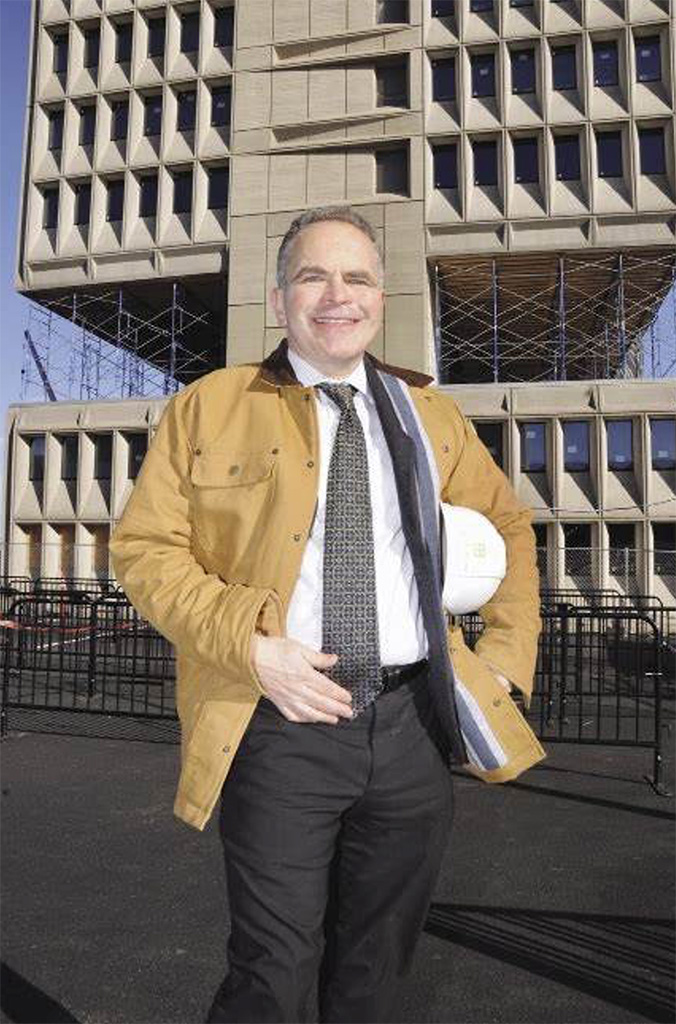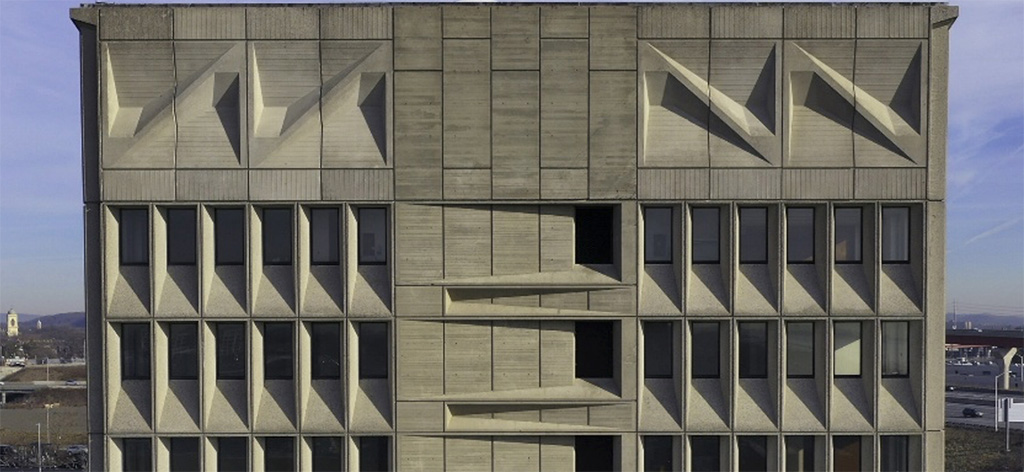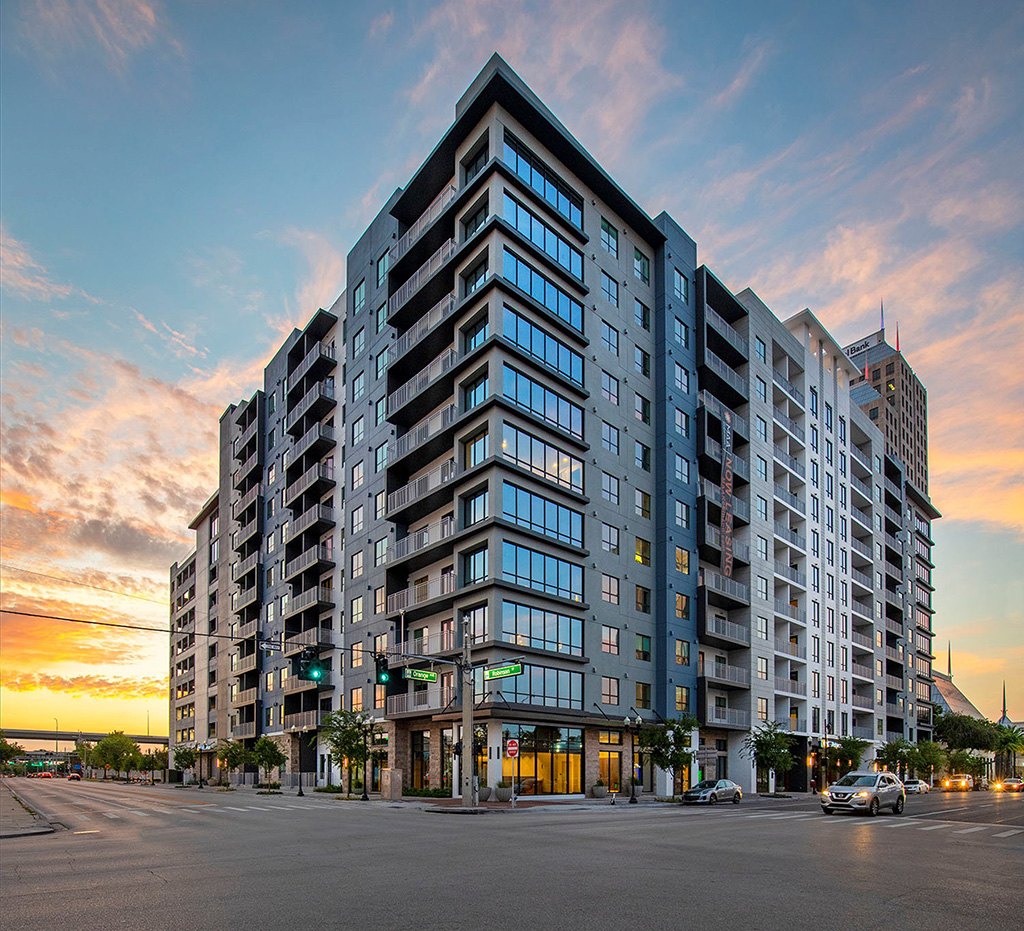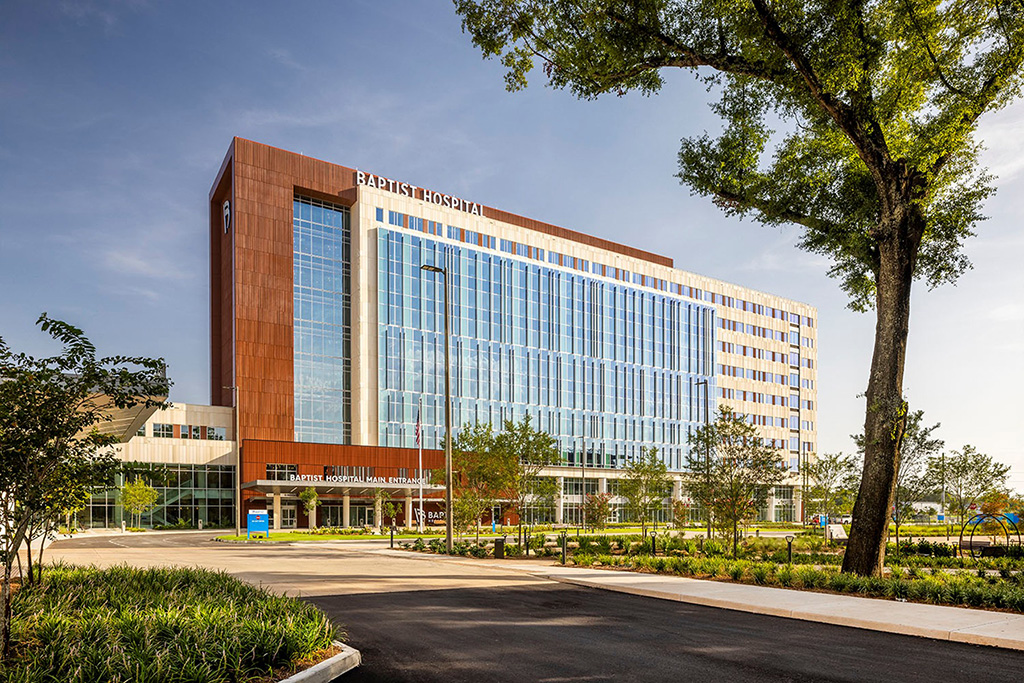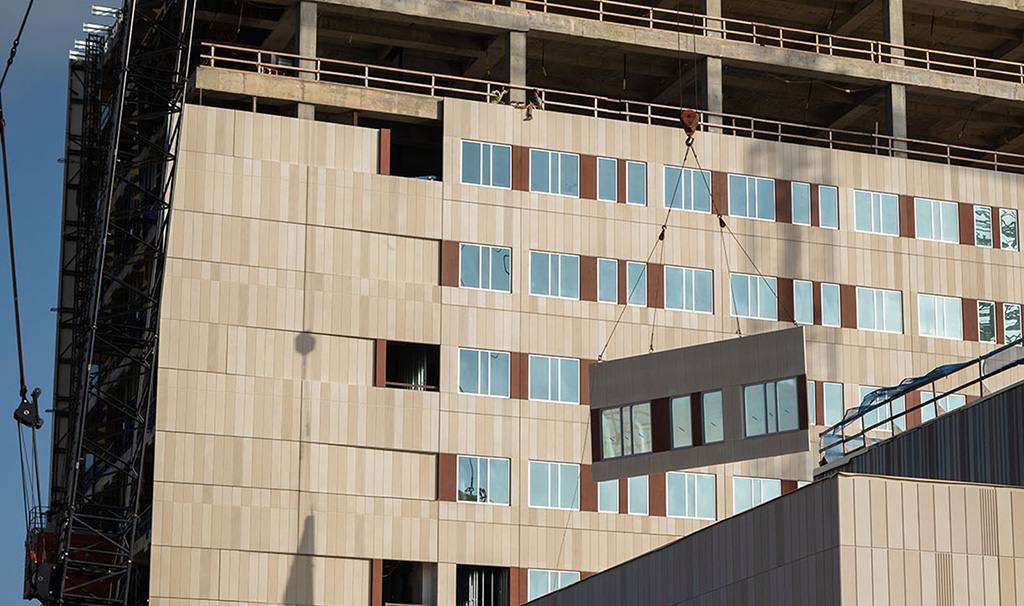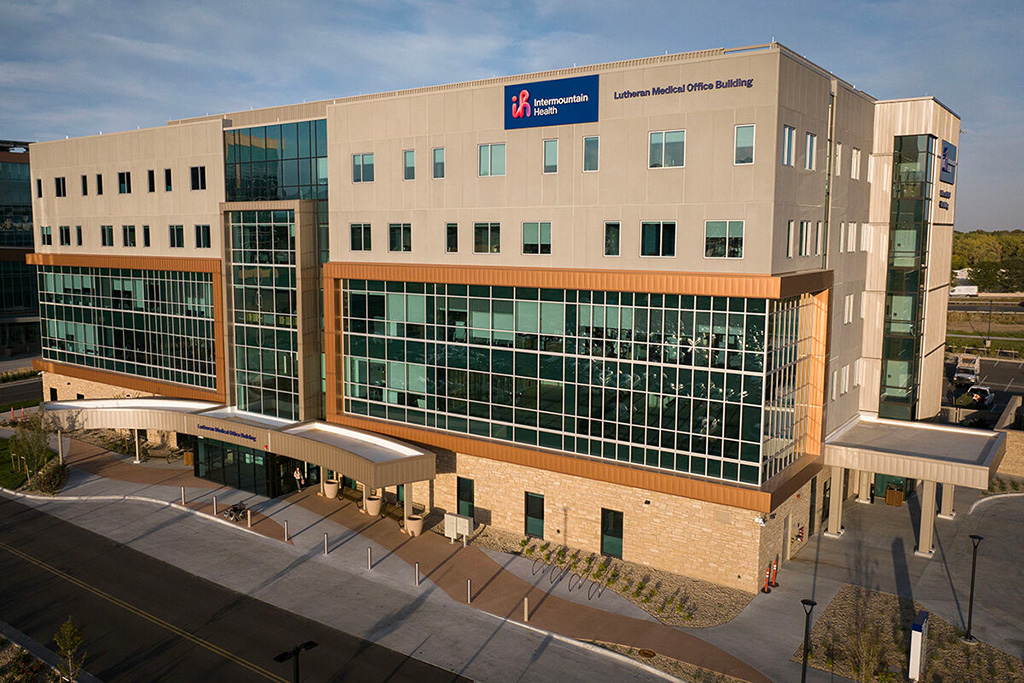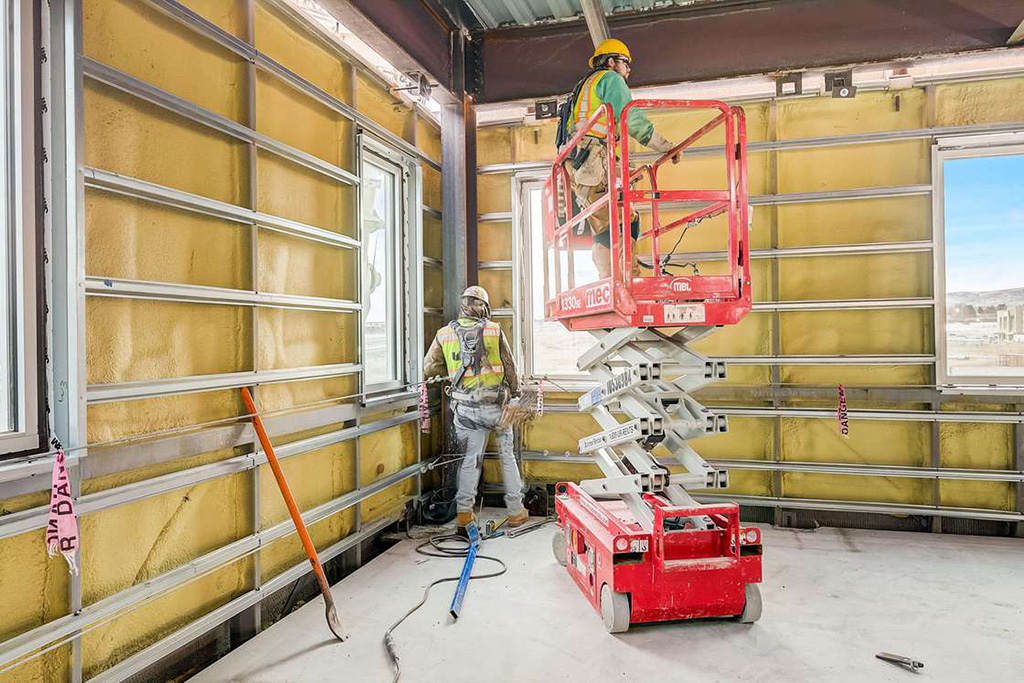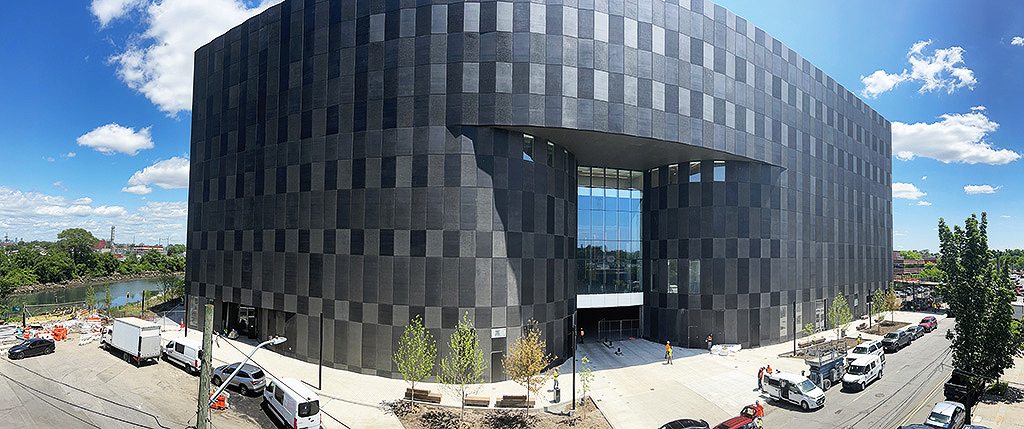
Photo courtesy of PCI
The facade of Wildflower Studios in Astoria, Queens, New York City, is comprised of 916 architectural precast concrete panels.Architect: Bjarke Ingels Group, Brooklyn, N.Y.
As architects, we are taught to select materials so that the true nature of the material aligns with its intended use. Frank Lloyd Wright was a master of this approach, which is why the title of Henry Russell Hitchcock’s treatise on Wright is titled In the Nature of Materials. Fay Jones’ Woodland Chapel evokes the branches and trunks of trees with wood timbers to create an inspirational setting in a forest. Louis Kahn also challenged students to imagine, “What does a brick want to be?” So, what do precast concrete building enclosure elements want to be? They want to be whatever the architect wants them to be.
Precast concrete can be formed into any shape or building enclosure element with applications that are liberating and limitless. More than any other material, architects and contractors have the freedom to determine the shape and composition of precast concrete building enclosures. They can be one piece of the building envelope puzzle, along with glass, brick, or stone, or they can be the entire puzzle with integrated insulation, interior finish, and windows already installed. The possibilities are endless and are shaped by the imagination of the architect.
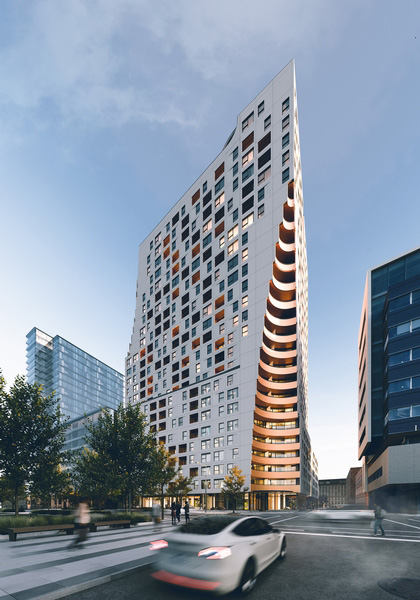
Photo courtesy of PCI
Six hundred white architectural precast panels with a light sand-blasted finish achieve the elegant exterior of the Odea in Montreal, Canada. Architect: Lemay, Montreal, Quebec.
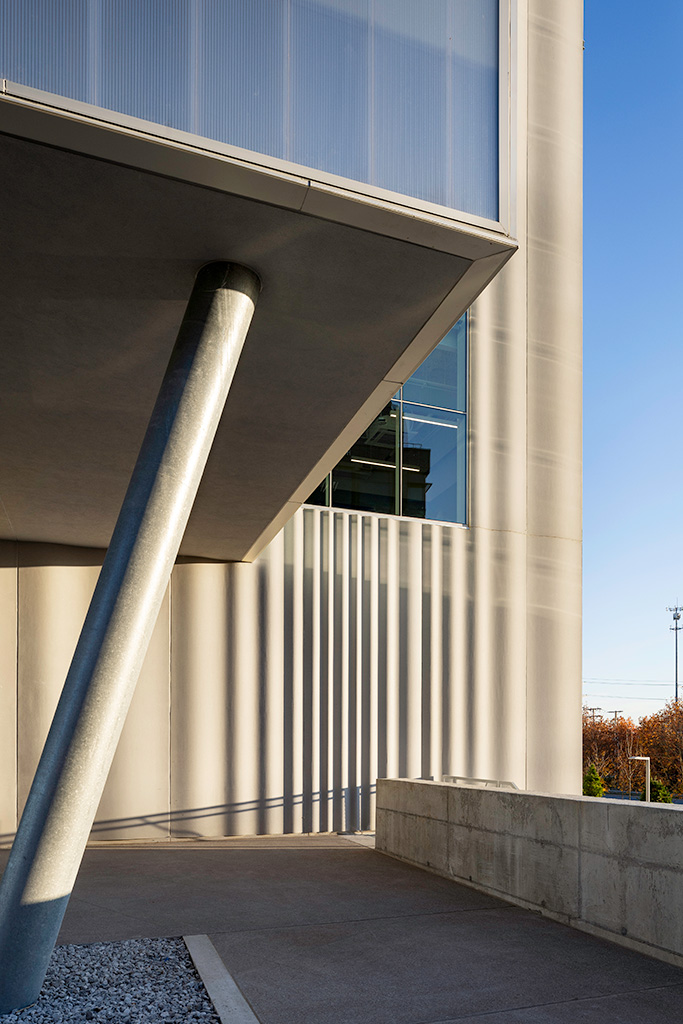
Photo courtesy of PCI
Detail of precast panels on the Ohio State University Energy Advancement and Innovation Center in Columbus, Ohio. Architects: Smith-Miller + Hawkinson, New York City, and Moody Nolan, Columbus, Ohio.
Precast Concrete Overview
Concrete itself is ubiquitous and has its origins in ancient history. As far back as 6,500 B.C., stone age populations were aware of the properties of using lime and water to create structures. The Greeks and then the Roman Empire are well known to have utilized concrete for architecture and infrastructure, and some of those structures are still standing today. The modern era and the popularity of concrete emerged alongside the development of Portland cement in 1824. This eventually led to the exponential growth of the use of concrete for buildings starting in the early 1900s.
A notable architect who pioneered the expressive use of concrete was Auguste Perret. He was a prolific architect and builder working from 1905-1950 who leveraged the natural properties of the material to create innovative, durable, and beautiful buildings. Interestingly, a young architect in Perret’s office who later became known as a pioneer of modernism, Le Corbusier, also embraced the material.
Le Corbusier developed a system of precast concrete structure for houses named Maison Domino, which utilized precast concrete columns and beams to create an affordable and versatile housing prototype. Another modern pioneer from the Bauhaus lineage, Marcel Breuer, also embraced the use of precast concrete panels that spanned floor to floor and included window openings (more on this later). And our American pioneer of modernism, Frank Lloyd Wright, also developed precast concrete enclosure elements in his textile blocks that were used to create affordable and attractive housing.
So, if precast concrete was seen as innovative by Le Corbusier, Marcel Breuer, and Frank Lloyd Wright at the birth of Modernism, how can we as architects best leverage its attributes today?
There is a lot of new information emerging about concrete and precast concrete that puts this material at another inflection point in its long history. Along with a recent focus on material selection and sustainability now being rolled out as the American Institute of Architects (AIA) Materials Pledge, it is important to analyze how precast concrete aligns with these goals.
As architects, we have to sort through a lot of data, much of it greenwashing or biased, related to systems and materials, to ultimately use our own professional judgment in making the many design decisions involved in creating architecture.
This article discusses the sustainability of precast concrete in some detail, including some “myth busting” related to its impact over time. It is this fourth dimension where precast concrete differentiates itself from other materials. It is both fast and slow - faster to the jobsite, resulting in reduced cost in time of construction, and slower in aging, resulting in an extraordinarily long expected useful life.
Precast Concrete Performance Characteristics
Before we launch into the types of precast concrete enclosure products and systems, let’s discuss the attributes that are common to all types. The intrinsic qualities of precast concrete are:
- Resistance to water and air, and fire penetration,
- Thermal mass – energy efficiency,
- Mass for acoustic privacy and
- Viscous with the opportunity to form virtually any shape.
While many materials and systems have one or more of these features, precast concrete sets itself apart in that they are all in one material. Permeability to water and air is extremely important in a building envelope, and precast concrete excels at providing a low permeability for both. This is primarily due to the composition of the material itself, but also due to the fact that the size of the units is larger than the alternatives, resulting in fewer joints. While concrete is permeable at a very low level, there are reports that estimate that it would take water approximately 4,800 years to travel through a 6-inch concrete wall of good quality. The final permeability of any individual element will be the result of several factors, starting with the water-to-cement ratio, followed by aggregate type and size, admixtures, and the method of manufacturing.
The ”pre” in precast of all types indicates the off-site fabrication of the material, which results in several advantages:
- The controlled setting of manufacturing the material allows for a lower water-to-cement ratio, resulting in higher strength and reduced permeability to both air and water.
- The increased strength achieved with off-site production allows the designer to create the same results with a leaner and smaller amount of material.
- The precision that is able to be accomplished in a plant setting also leads to less waste in the overall process and a superior quality panel with less chance of segregation of paste and aggregate than is more likely to occur in an on-site concrete placement.
- The material arrives at the site ready to be erected, shortening the construction time. This can speed up an overall project, which saves cost but also reduces on-site construction crew travel, which saves commuting long distances to job sites and the resulting expense and emissions.
- Precast concrete plants are located in all 48 states of the continental United States, with concentrations near population centers where larger building projects are most often located.
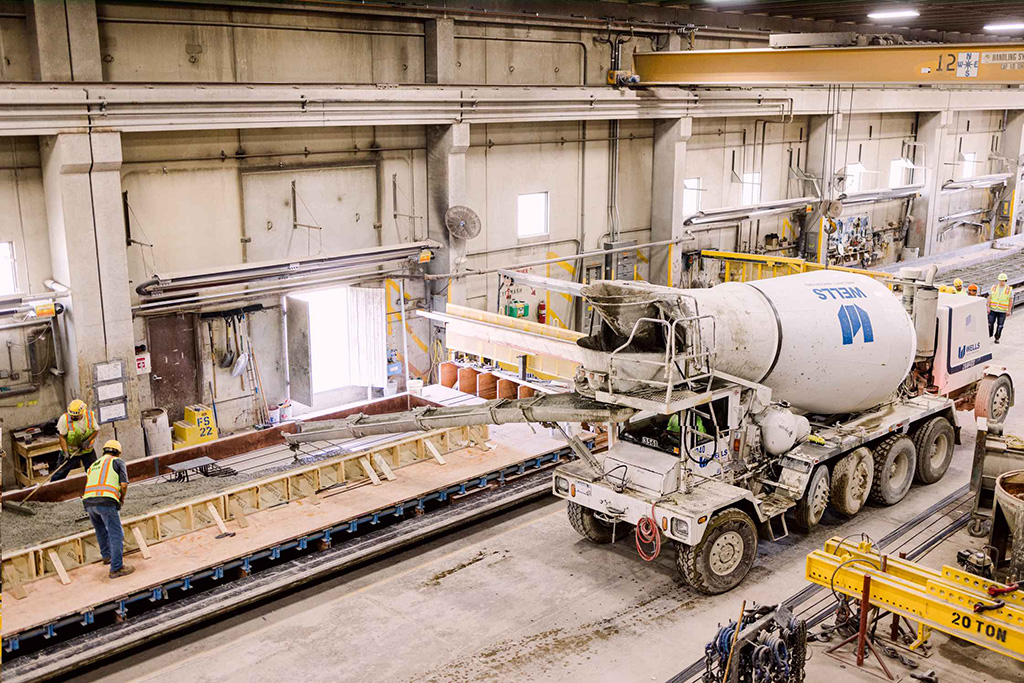
Photo courtesy of Wells Concrete
Panels being cast in the plant with a controlled environment, resulting in higher strength, less waste, more precision, and safer work settings.
Since precast concrete enclosure elements are highly impermeable to moisture and air infiltration, there are two options for how to incorporate them into your building envelope.
- Rain Screen Systems – These systems typically have an outer layer or material that is expected or planned to fail. A second layer is then introduced to further protect the structure. Importantly, these systems also include an interstitial cavity that is weeped to the exterior. These systems are widely in use, and many contractors understand the principles and installation procedures. However, there are many opportunities for things to go wrong, especially with flashings around openings, ensuring free passage of moisture in the cavity and effective weeping of the cavity so all of the moisture exits the structure. Precast concrete elements installed in this manner tend to be the smaller units and are combined with brick or cement fiber panels that are best installed in a rain screen configuration.
- Barrier Systems – Precast concrete really wants to be a barrier system. It is so highly impervious that a second layer and a cavity would not only be impractical but also of little to no value. Other barrier systems and materials are widely used in commercial construction, including glazing and membrane roofing systems. Concrete is well known to resist water penetration, which is why it is used for dams and swimming pool construction. Many of us architects were taught to “dress our buildings in layers” to keep them dry and warm, and are sometimes uncomfortable with barrier systems. Some of us remember the notable failure of early synthetic stucco systems that were sold as barrier systems and quickly failed spectacularly, causing liability to designers and millions in damage to building owners and contractors. While outdoor clothing is often layered, it is more appropriate to think of precast concrete as the “dry suit” that commercial fishermen, white water kayakers, and ocean sailors rely on to keep them dry with plenty of space for warmer layers underneath. This is not to say that attention is not needed to be paid to the details of barrier systems, as there will always be some joints that typically employ a two-stage or rain screen configuration. Larger precast concrete units are best suited for installation in a barrier configuration.
The other common characteristics of precast concrete enclosure systems are more straightforward and related to the composition and weight of the material. Precast concrete is inherently noncombustible and resists the passage of heat and fire due to its mass. Similarly, the weight and impervious characteristics of the panels, assuming they are properly anchored, provide extraordinary resistance to wind and air infiltration, as you will see in some of the case studies later in this article. And due to these same features, precast concrete resists the passage of sound, making it an excellent choice where acoustic privacy is desired.
Resiliency is important for all enclosure systems today, and again, precast concrete is unique in its ability to resist the forces of severe weather events. Precast concrete is often fastened directly to the primary structural frame, so it transfers wind loads to the building element most capable of resisting unusually strong winds in hurricanes and other high-wind weather events. Other systems rely on intermediary backup walls or furring systems, which are less effective in directly resisting lateral forces. Precast concrete building enclosure elements can be specified to resist wind forces well in excess of code requirements where resiliency is a major concern.
Precast concrete is also inert, so it does not off-gas. Care should be taken with sealers and admixtures, and proper curing time to fully ensure that concrete provides healthy indoor air quality.

Photo courtesy of PCI
The facade of Wildflower Studios in Astoria, Queens, New York City, is comprised of 916 architectural precast concrete panels.Architect: Bjarke Ingels Group, Brooklyn, N.Y.
As architects, we are taught to select materials so that the true nature of the material aligns with its intended use. Frank Lloyd Wright was a master of this approach, which is why the title of Henry Russell Hitchcock’s treatise on Wright is titled In the Nature of Materials. Fay Jones’ Woodland Chapel evokes the branches and trunks of trees with wood timbers to create an inspirational setting in a forest. Louis Kahn also challenged students to imagine, “What does a brick want to be?” So, what do precast concrete building enclosure elements want to be? They want to be whatever the architect wants them to be.
Precast concrete can be formed into any shape or building enclosure element with applications that are liberating and limitless. More than any other material, architects and contractors have the freedom to determine the shape and composition of precast concrete building enclosures. They can be one piece of the building envelope puzzle, along with glass, brick, or stone, or they can be the entire puzzle with integrated insulation, interior finish, and windows already installed. The possibilities are endless and are shaped by the imagination of the architect.

Photo courtesy of PCI
Six hundred white architectural precast panels with a light sand-blasted finish achieve the elegant exterior of the Odea in Montreal, Canada. Architect: Lemay, Montreal, Quebec.

Photo courtesy of PCI
Detail of precast panels on the Ohio State University Energy Advancement and Innovation Center in Columbus, Ohio. Architects: Smith-Miller + Hawkinson, New York City, and Moody Nolan, Columbus, Ohio.
Precast Concrete Overview
Concrete itself is ubiquitous and has its origins in ancient history. As far back as 6,500 B.C., stone age populations were aware of the properties of using lime and water to create structures. The Greeks and then the Roman Empire are well known to have utilized concrete for architecture and infrastructure, and some of those structures are still standing today. The modern era and the popularity of concrete emerged alongside the development of Portland cement in 1824. This eventually led to the exponential growth of the use of concrete for buildings starting in the early 1900s.
A notable architect who pioneered the expressive use of concrete was Auguste Perret. He was a prolific architect and builder working from 1905-1950 who leveraged the natural properties of the material to create innovative, durable, and beautiful buildings. Interestingly, a young architect in Perret’s office who later became known as a pioneer of modernism, Le Corbusier, also embraced the material.
Le Corbusier developed a system of precast concrete structure for houses named Maison Domino, which utilized precast concrete columns and beams to create an affordable and versatile housing prototype. Another modern pioneer from the Bauhaus lineage, Marcel Breuer, also embraced the use of precast concrete panels that spanned floor to floor and included window openings (more on this later). And our American pioneer of modernism, Frank Lloyd Wright, also developed precast concrete enclosure elements in his textile blocks that were used to create affordable and attractive housing.
So, if precast concrete was seen as innovative by Le Corbusier, Marcel Breuer, and Frank Lloyd Wright at the birth of Modernism, how can we as architects best leverage its attributes today?
There is a lot of new information emerging about concrete and precast concrete that puts this material at another inflection point in its long history. Along with a recent focus on material selection and sustainability now being rolled out as the American Institute of Architects (AIA) Materials Pledge, it is important to analyze how precast concrete aligns with these goals.
As architects, we have to sort through a lot of data, much of it greenwashing or biased, related to systems and materials, to ultimately use our own professional judgment in making the many design decisions involved in creating architecture.
This article discusses the sustainability of precast concrete in some detail, including some “myth busting” related to its impact over time. It is this fourth dimension where precast concrete differentiates itself from other materials. It is both fast and slow - faster to the jobsite, resulting in reduced cost in time of construction, and slower in aging, resulting in an extraordinarily long expected useful life.
Precast Concrete Performance Characteristics
Before we launch into the types of precast concrete enclosure products and systems, let’s discuss the attributes that are common to all types. The intrinsic qualities of precast concrete are:
- Resistance to water and air, and fire penetration,
- Thermal mass – energy efficiency,
- Mass for acoustic privacy and
- Viscous with the opportunity to form virtually any shape.
While many materials and systems have one or more of these features, precast concrete sets itself apart in that they are all in one material. Permeability to water and air is extremely important in a building envelope, and precast concrete excels at providing a low permeability for both. This is primarily due to the composition of the material itself, but also due to the fact that the size of the units is larger than the alternatives, resulting in fewer joints. While concrete is permeable at a very low level, there are reports that estimate that it would take water approximately 4,800 years to travel through a 6-inch concrete wall of good quality. The final permeability of any individual element will be the result of several factors, starting with the water-to-cement ratio, followed by aggregate type and size, admixtures, and the method of manufacturing.
The ”pre” in precast of all types indicates the off-site fabrication of the material, which results in several advantages:
- The controlled setting of manufacturing the material allows for a lower water-to-cement ratio, resulting in higher strength and reduced permeability to both air and water.
- The increased strength achieved with off-site production allows the designer to create the same results with a leaner and smaller amount of material.
- The precision that is able to be accomplished in a plant setting also leads to less waste in the overall process and a superior quality panel with less chance of segregation of paste and aggregate than is more likely to occur in an on-site concrete placement.
- The material arrives at the site ready to be erected, shortening the construction time. This can speed up an overall project, which saves cost but also reduces on-site construction crew travel, which saves commuting long distances to job sites and the resulting expense and emissions.
- Precast concrete plants are located in all 48 states of the continental United States, with concentrations near population centers where larger building projects are most often located.

Photo courtesy of Wells Concrete
Panels being cast in the plant with a controlled environment, resulting in higher strength, less waste, more precision, and safer work settings.
Since precast concrete enclosure elements are highly impermeable to moisture and air infiltration, there are two options for how to incorporate them into your building envelope.
- Rain Screen Systems – These systems typically have an outer layer or material that is expected or planned to fail. A second layer is then introduced to further protect the structure. Importantly, these systems also include an interstitial cavity that is weeped to the exterior. These systems are widely in use, and many contractors understand the principles and installation procedures. However, there are many opportunities for things to go wrong, especially with flashings around openings, ensuring free passage of moisture in the cavity and effective weeping of the cavity so all of the moisture exits the structure. Precast concrete elements installed in this manner tend to be the smaller units and are combined with brick or cement fiber panels that are best installed in a rain screen configuration.
- Barrier Systems – Precast concrete really wants to be a barrier system. It is so highly impervious that a second layer and a cavity would not only be impractical but also of little to no value. Other barrier systems and materials are widely used in commercial construction, including glazing and membrane roofing systems. Concrete is well known to resist water penetration, which is why it is used for dams and swimming pool construction. Many of us architects were taught to “dress our buildings in layers” to keep them dry and warm, and are sometimes uncomfortable with barrier systems. Some of us remember the notable failure of early synthetic stucco systems that were sold as barrier systems and quickly failed spectacularly, causing liability to designers and millions in damage to building owners and contractors. While outdoor clothing is often layered, it is more appropriate to think of precast concrete as the “dry suit” that commercial fishermen, white water kayakers, and ocean sailors rely on to keep them dry with plenty of space for warmer layers underneath. This is not to say that attention is not needed to be paid to the details of barrier systems, as there will always be some joints that typically employ a two-stage or rain screen configuration. Larger precast concrete units are best suited for installation in a barrier configuration.
The other common characteristics of precast concrete enclosure systems are more straightforward and related to the composition and weight of the material. Precast concrete is inherently noncombustible and resists the passage of heat and fire due to its mass. Similarly, the weight and impervious characteristics of the panels, assuming they are properly anchored, provide extraordinary resistance to wind and air infiltration, as you will see in some of the case studies later in this article. And due to these same features, precast concrete resists the passage of sound, making it an excellent choice where acoustic privacy is desired.
Resiliency is important for all enclosure systems today, and again, precast concrete is unique in its ability to resist the forces of severe weather events. Precast concrete is often fastened directly to the primary structural frame, so it transfers wind loads to the building element most capable of resisting unusually strong winds in hurricanes and other high-wind weather events. Other systems rely on intermediary backup walls or furring systems, which are less effective in directly resisting lateral forces. Precast concrete building enclosure elements can be specified to resist wind forces well in excess of code requirements where resiliency is a major concern.
Precast concrete is also inert, so it does not off-gas. Care should be taken with sealers and admixtures, and proper curing time to fully ensure that concrete provides healthy indoor air quality.
Durability
The durability and life cycle characteristics of precast concrete enclosure elements warrant a longer discussion and some background on the ways that life cycle assessments (LCA) are viewed. As with all data related to building science, this too needs the architect’s informed judgment to form an actionable opinion on the benefits of the material or system.
There are four stages to the life of a product or material as defined by ISO 21930, and a fifth if the product is to be recycled or have other benefits after the end of its life. The table below shows a rough correlation with these definitions and the more commonly used designations first put forth by architect William McDonough and chemist Michael Broungart in their groundbreaking 2002 book titled Cradle to Cradle.
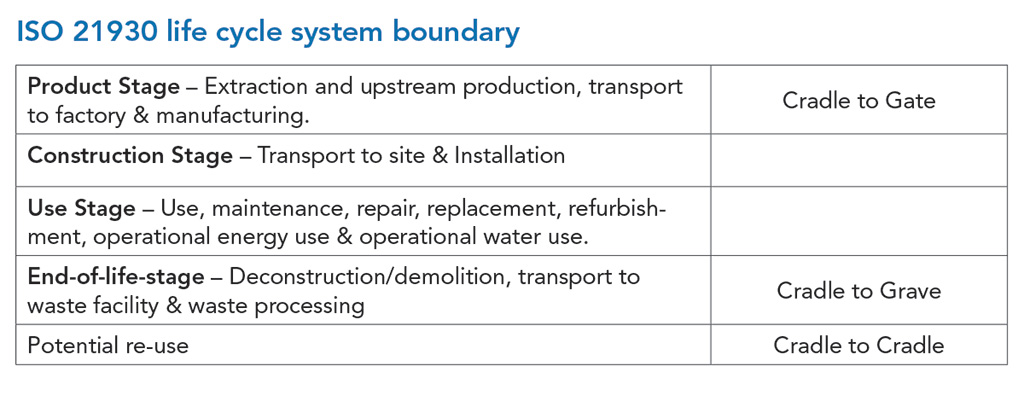
While there is some variance of opinion in reference literature, the Cradle to Grave expected useful life for precast concrete structure and enclosure is in the 75-100 year range. This is an extraordinarily long life when compared with other popular choices; curtain wall (40), stucco (35), aluminum panel (50) (for more information on life cycle cost refer to, “Life Cycle Costing for Facilities” by Alphonse J. Dell Isola PE and Stephen J. Kirk, FAIA).
When viewing the life cycle cost and environmental impact of materials and systems, it is critical to keep in mind the holistic view of their entire life cycle. Interior materials are thought to have approximately a 15-year expected useful life. So, if they are to be compared to materials and systems such as precast concrete, their cost and environmental impact would need to be multiplied 5-7 times. It seems that the cost or environmental impact, per year of service life, has yet to be recognized as the best way to evaluate materials and systems, as the industry and society in general tend to focus on the more immediate cradle-to-gate impacts and the first or initial cost of materials and systems.
Extraordinary durability has another long-term benefit – adaptive re-use. It is well known that one of the most sustainable buildings is an existing one that can be effectively renewed for a new use. There are many fine examples of effective renovations of buildings with precast concrete exteriors, with one of the most notable being the recent Hotel Marcel project in New Haven (see sidebar).
Another indication of the long life of precast concrete building enclosures is the fact that the Precast/Prestressed Concrete Institute had an entire awards program dedicated to longevity. Some of these projects still look relevant and new at 60 years and older. It is hard to imagine other industry associations giving awards to 60-year-old materials—think about a 60-year-old carpet!
Design with Precast Concrete
In the following sections, we discuss precast concrete building enclosure elements in four broad categories:
- Precast concrete trim units – These are typically hand-placed in a rainscreen or cavity wall configuration and can be combined with other masonry units or building enclosure elements.
- Precast glass fiber reinforced concrete units – Similar to above, these units can be a portion of the composite building envelope or the entire surface of the exterior. They are lower in overall weight and easily shaped into attractive profiles.
- Precast concrete wall panels – These can be any size or shape and are typically solid concrete and installed in a barrier configuration, and fastened to the structural frame.
- Precast concrete composite or sandwich wall panels – Similar to above, these are fastened to the structural frame and can include insulation, interior finishes, and windows.
- Precast Concrete trim units – This type of enclosure element is typically designed to complement other smaller masonry units, including brick, dimensional stone, or ground face block in a cavity wall configuration. The depth of the unit is typically a nominal 4 inches to align with other units in the overall wall assembly. Unlike dimensional stone or brick, it is easy to embed anchorage into the unit itself, making it easier to erect and assuring that wind loads can be transferred to the backup wall and primary structural frame. Weights of these units will vary with the mix to make sure that it is reasonable for two masons to set the unit if it is part of a brick or stone system. Larger pieces will require a lift or crane to set in place. Typical applications include: base courses, belt courses, windowsills and surrounds, corner (“coins”), and cornice pieces.
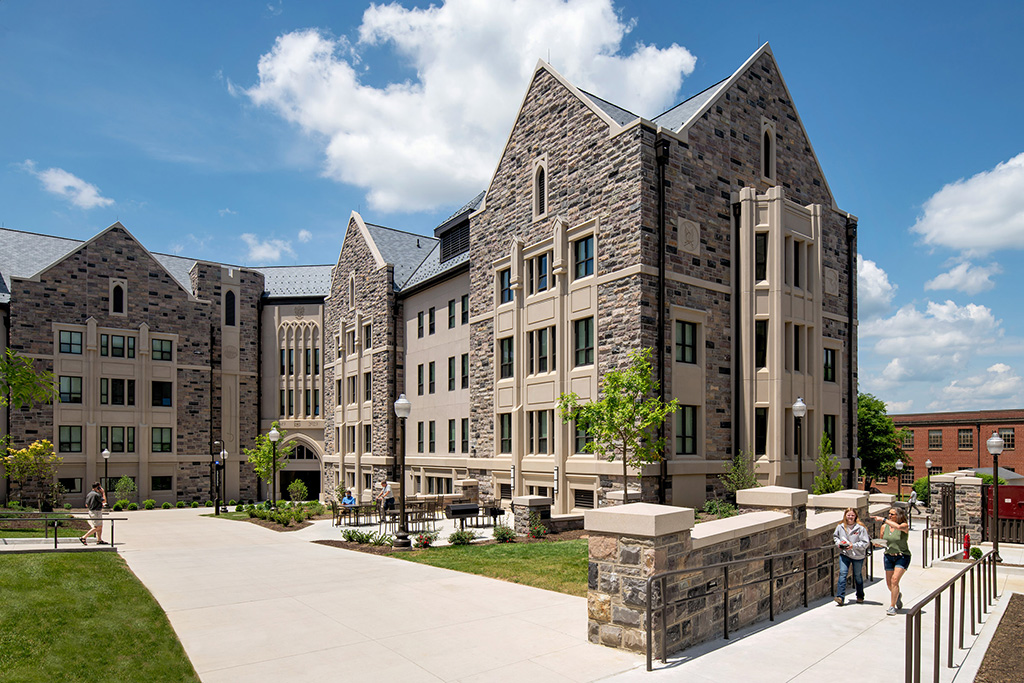
Photo courtesy of PCI
Architectural precast concrete can be used with other materials to create detailed profiles to complete the Collegiate Gothic style shown here at a new building at Virginia Tech in Blacksburg, Virginia.
Cast stone, which is technically a type of concrete, is a different material composition generally, with more fine aggregates and consolidated by dry tamping. There is significant overlap between the two products, so the architect should select based on the overall effect that is being sought. Architectural precast concrete panels generally can show more texture with larger aggregate. Units can be cast in a single or multiple colors, with reveals and bullnoses, and other decorative patterns to meet the aesthetic goals of the project.
- Glass Fiber Reinforced Concrete (GFRC) – This series of products includes glass fiber to strengthen the piece, making it suitable for more elaborate shapes and a lighter overall weight. With an overall weight that can be 80% less than architectural precast, this can also result in savings in the supporting primary structure. The range of possible shapes and sharper edge details available in GFRC makes it a viable alternative to terra cotta, cast stone, limestone, granite, and sandstone. It is not only lighter but also more cost-effective than these alternatives. Due to its light weight and resistance to cracking, GFRC is an ideal choice for building enclosures in seismic zones. It can be installed as part of a cavity wall system or as a barrier system.
- Solid Precast Concrete Panels – This is probably the most historically traditional application of architectural precast concrete as part of a building enclosure.
They are typically larger, solid concrete panels, often spanning vertically (floor to floor) or horizontally (column to column) and are anchored directly to the structural frame of the building. They can be fabricated as a full panel or with a window openings. Off-site production of the panels allows building enclosure to be achieved shortly after the primary frame and floor slabs are in place, which can significantly shorten the project’s construction phase. The installation of the backup wall (typically lightweight metal framing), windows, insulation, mechanical and electrical roughing, and finishes can proceed in the normal sequence of construction with on-site trades. This configuration also has a long-term benefit in that other elements of the wall systems that have a shorter expected useful life, such as windows and wall finishes, can later be replaced without impacting the precast concrete panels, which have an extraordinarily long expected useful life.
As mentioned earlier, this configuration really wants to be a barrier-type system for a number of reasons. Since it is fastened directly to the structural frame, it is challenging to have these connections penetrate a secondary layer of moisture protection and be successfully flashed and made watertight. The sequence of erection also poses a practical issue with how and when the backup layer is installed. And most importantly, this is not necessary with a virtually impervious material.
There will, of course, be joints between the panels, and special care needs to be taken with how these are accomplished. The recommended approach is to utilize a two-stage sealant process that is, in effect, a rain screen joint system. This involves a backer rod and sealant at the back of the joint, and then a cavity with another backer rod and sealant at the exterior face of the joint. This outer layer is interrupted at floor levels and above openings with a weep opening. As with any wall system, sub-sill flashings at window openings and other penetrations need to be included. (For more information on this approach, refer to the white paper entitled, “High Performance Precast Concrete Building Enclosures: Rain Control” by John Straube, Ph.D., P.E. – Building Science Corporation).
Precast Concrete Composite/Sandwich Panels
The construction industry has been on a path towards partial or full prefabrication for a long time, and this continues today. Not too long ago, door openings, windows, skylights, and millwork were largely assembled or made onsite, and today it would seem arcane not to utilize these ready-made building elements. The result of off-site fabrication is generally higher quality and speedier installation at the project site.
This type of precast concrete panel can arrive on site with not only the exterior concrete facing but also insulation, windows, interior backup wall, and interior finishes already applied. This ready-made exterior panel lends itself to some project types more than others, but has been utilized for data centers, warehouses, and office buildings. The manufacturers that produce these panels can advise the architect on how to incorporate some or all of the elements that comprise the sandwich panel. Like the panels discussed previously, these are also installed in a barrier configuration. The advantage of this type of panel is an even more significant reduction of onsite construction time, as the exterior wall system can be fabricated at the same time as the frame is being erected on site. The increased quality control available in a factory setting, with not only the concrete panel but also the window installation, insulation, sealants, and framing, is also a major benefit.
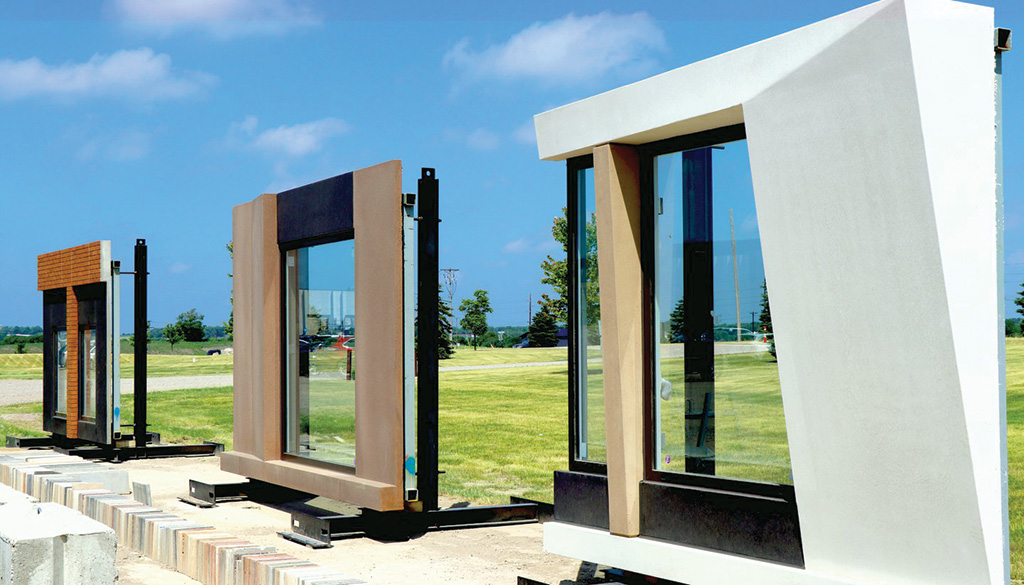
Photo courtesy of Wells
Precast concrete architectural composite/sandwich panels undergoing testing.
Green Building and Precast Concrete
Sustainability related to materials, building systems, and completed structures, and how it is evaluated, is complicated. It is easy to plunge into the rabbit hole of acronyms and to get increasingly annoyed or confused by how each system or category is evaluated. The number of eco-labels has multiplied in recent years, each with an origin or emphasis in different valid categories, including energy use, resource utilization, carbon use, and health. Again, this will require judgment by the architect as no single scorecard or certification tells the whole story.
Environmental Product Declarations (EPD)
Concrete is a significant contributor to the amount of embodied carbon attributed to the building sector. While its carbon footprint is lower than aluminum or glass, it has a large impact because it is so widely used in construction. The entire industry, from cement production to precast concrete, is working to reduce the carbon footprint of concrete, and progress is being made.
Any evaluation has to start with full disclosure of the impacts. The Environmental Product Declaration or EPD is the uniform reporting tool that provides this data. Each evaluation is subject to the Product Category Rules or PCR for that material. In May of 2025, new EPDs were released industry-wide for different types of precast concrete enclosure products for each region, as the industry is responsibly addressing its obligation to help architects and contractors make informed decisions.
Since EPDs are necessarily produced by the manufacturer, they can only look at the first phase of the product’s useful life, cradle to gate. As discussed earlier, this is only a small portion of the impact of the material over its expected useful life, especially for precast concrete enclosures that have such an extraordinarily long life. (For a more in-depth discussion of EPDs in the precast concrete industry, refer to The Designer’s Notebook by the PCI, Suitability of Environmental Product Declarations in Material Selection.
Precast concrete is generally comprised of water, aggregate (coarse and fine), and a binder, most commonly Portland cement. The production of Portland cement is the largest contributor to the use of carbon in making concrete, and it is all in the cradle-to- gate phase of the product. The effort to reduce the embodied carbon in concrete is showing progress in reducing the impacts of all three ingredients. As mentioned earlier, due to precast concrete enclosure elements being fabricated in a controlled environment, they use a lower water-to-cement ratio than the alternatives, so they are using less water. Alternative cementitious materials are being explored by a range of manufacturers that include fly ash, recycled products, and waste products from steel production.
It is with supplemental cement products that there is an acceleration and explosion of alternatives. These show terrific promise and are being aggressively promoted. At the most recent AIA conference in Boston, there were a number of new products showcased, including cement-free concrete and super lightweight interior and exterior panels. Many of these alternative products are already in use, have some test data available, and by all published accounts are very successful alternatives. (For more information on the accelerating changes to the concrete industry, refer to a recent AIA Architect article entitled “Low-carbon concrete solutions are showing high potential.”)
Product Certifications, including EPD’s are challenging to utilize in an industry that customizes the manufacturing for its products on a per-project basis. The production of concrete, including precast concrete, seems to be changing at an accelerated rate, mostly as a legitimate reaction to the concern about how much carbon is used to create concrete. If you are involved in commercial or institutional projects, which can take 3-5 years to design and complete, the EPD available to you during design is for the product that was developed yesterday, typically the EPD for the product that is being producing today is not yet available and it is likely that by the time you receive submittals and shop drawings it will be tomorrow’s unevaluated product. This continual “analyze and evolve” process will require acumen and attention from the entire industry as concrete continues on its path to reduce its overall environmental impact.
Energy Performance
Concrete is a natural insulator to a certain extent. The U value will vary with the composition of the concrete, especially the aggregate selection. It insulates better than windows and doors and is roughly equivalent to other masonry walls. Analysis of the entire wall section is appropriate to evaluate the insulating value of the total building envelope. Care also needs to be taken to ensure you have adequate insulation inside to avoid condensation on the inside face of the exterior concrete. This is critical to avoiding the buildup of moisture in this space. The proper thermal profile in the wall and installation of air and vapor barriers are always important to ensure proper performance of the wall system. Another critical detail that will require your attention is how the precast concrete is attached to your backup wall or primary structural frame. Proper thermal breaks or insulation of your connectors with spray foam will be needed to both prevent energy transfer and prevent condensation and rust on structural connection points.
Thermal mass acts like a storage battery that can prevent large interior temperature swings in both hot and cold seasons. Concrete is the ideal thermal mass material and has been heavily utilized in passive solar applications for many years. It is effective when it is inside the thermal envelope of the structure, as it is with precast concrete insulated sandwich panels. Another application is when interior concrete panels are fastened to studs or furring systems on the warm side of insulation. Avoiding large temperature swings through the introduction of precast concrete as a thermal mass can save significant operational costs over the life of a structure.
Local Materials
A key principle of sustainable construction is to source materials locally. Precast concrete manufacturers are spread across the continental United States, and each location or plant makes its own product or products (you can find an interactive map of all precast concrete plants on the PCI website: www.pci.org/PCI/Directories/Map.aspx). It is likely that in most major urban centers, you can find a supplier within a few hundred miles to make the product you need. This decentralized industry model varies significantly from other manufacturers of major components of the building envelope, such
as windows, curtain wall, or brick, so it will take some research to find the best precast concrete supplier for your project. The ability to make the precast concrete pieces you need for building enclosures from locally sourced materials also varies with each location. While in general, aggregates are sourced nearby, cement may not be. Certainly, when compared to aluminum curtain wall or insulated metal panel exteriors, precast concrete is much more available from local or regional manufacturers.
Specifying Precast Concrete
How do we responsibly specify precast concrete building enclosure elements today in light of the AIA Materials Pledge and other industry guidance? The common materials framework, or CMF, that is incorporated into the pledge requires manufacturers to provide up-to-date EPDs. Precast concrete industry-wide EPDs from May 2025 address two of the CMF’s most important categories: Ecosystem Health and Climate Health. These EPDs are not positive or negative but provide transparency and data so architects can make informed decisions.
The project delivery strategy for incorporating precast concrete enclosure elements in your project will vary based on your design. For smaller units or GFRC pieces, a conventional specification and detailing on drawings will most likely be adequate to solicit bids from a number of qualified suppliers. There are a lot of resources available from suppliers for these products, including standard form specifications and BIM object models that can be incorporated into your design and construction documents. It is also important to check that the manufacturer meets industry quality control standards for the products you are specifying. Trade associations, such as the Precast/Prestressed Concrete Institute (PCI), are typically the best source for standards and certifications.
For larger solid or sandwich panels, it may be best to employ an integrated project delivery or design-build approach. Early collaboration with the manufacturer can provide many benefits to the finished construction and save time and cost. Manufacturers have a lot of experience and can help architects refine “the art of the possible” so that you both can realize your goals. Most of the larger manufacturers have in-house engineering, so it may be best to work with the precast concrete experts to delegate this portion of the design implementation. Like curtain walls, lightweight metal framing, and other more or less proprietary systems, this can be done in collaboration with your structural engineer without relinquishing any aspect of the architect’s established aesthetic approach.
Successful collaborations with engineers, builders, and materials suppliers typically yield the best overall project results. With continually increasing digital design and manufacturing production techniques, this collaboration can be even more effective. Since precast concrete is made in controlled settings, some manufacturers can actually use CNC machines for custom forms or a laser to project an image from a digital file directly onto the flat bed forms that will be used to make the precast panel for your project.
Proprietary specifications can be problematic when faced with public bidding requirements where “or equal” clauses are mandated. Architects should work with attorneys for the Owner, where this may prevent a high-quality precast concrete product from being specified due to its nature as a “sole source” provider. There are other possible procurement techniques to incorporate the precast concrete panels the architects want to use into publicly bid projects, including: staged bidding, establishing a materials allowance, and specifying at least three products that may be able to be used.
Conclusion
There is a lot to consider with precast concrete building envelope approaches, and hopefully, this overview has piqued your interest and given you some background as a designer and specifier. Like so many products in our culture today, we are likely to continue to see change or accelerated change in what is available, especially as efforts mature to reduce the carbon impact of the products.
Architects relish access to a rich palette of materials to realize their visions. The opportunities with precast concrete are again liberating and limitless. Architects and builders have been effectively using precast concrete from ancient times to the modern masters of architecture, and up to today and tomorrow. There is no doubt that precast concrete building enclosure elements are sustainable, durable, attractive, and affordable.
As Architects consider the wide range of possibilities available in utilizing precast concrete building enclosure elements, it will take time and careful analysis to imagine the best solution. Or you might say… It may take time to form a concrete way forward.
Russell A Davidson, FAIA, served as a volunteer leader of the Architecture profession in numerous roles in the American Institute of Architects, including AIA New York State President and AIA National President. He is a former president and principal of KG+D Architects, an award-winning firm in New York’s Hudson Valley.








